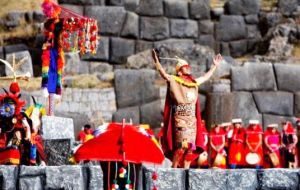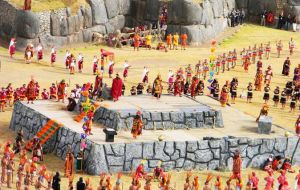MercoPress. South Atlantic News Agency
Some 50.000 tourists gather for the Sun Festival at Cuzco in the Peruvian Andes
 Sacsayhuaman Archaeological Park welcomed more than 50,000 domestic and foreign tourists, who witnessed the main festivity of the stunning festival.
Sacsayhuaman Archaeological Park welcomed more than 50,000 domestic and foreign tourists, who witnessed the main festivity of the stunning festival.  The first ceremony was held at Qoricancha Temple, where the Inca —escorted by his entourage— sang to the Inti (Sun God).
The first ceremony was held at Qoricancha Temple, where the Inca —escorted by his entourage— sang to the Inti (Sun God).  Inti Raymi takes place once a year in Cusco, between the end of the harvest and the beginning of the vernal equinox of the Andes, in the second half of June.
Inti Raymi takes place once a year in Cusco, between the end of the harvest and the beginning of the vernal equinox of the Andes, in the second half of June. Some 50,000 people gathered on the surrounding hills of Cusco (Emufec) in Peru with the purpose of seeing the impressive Inti Raymi event, which takes place on 3 scenes staged in 3 different places.
More than 3,600 tourists enjoyed the spectacular performance of Inti Raymi, also known as Sun Festival, from an area established by the Municipal Company of Festivities.
Sacsayhuaman Archaeological Park on Sunday welcomed more than 50,000 domestic and foreign tourists, who witnessed the main festivity of the stunning festival.
The first ceremony was held at Qoricancha Temple, where the Inca —escorted by his entourage— sang to the Inti (Sun God).
The second one took place at Cusco’s main square, where the Inca reenacted the famous Two Worlds Encounter scene. Lastly, the main ceremony was performed at Sacsayhuaman Fortress, one of Cusco’s emblematic attractions.
The Inti Raymi is a cultural manifestation that takes place once a year in Cusco —capital of former Tahuantinsuyo Empire— between the end of the harvest period and the beginning of the vernal equinox of the Andes, in the second half of June.
Held between May and June, the observance served to welcome a new year and put the previous “crop year” in the past.
Shortly after that, the new agricultural cycle used to begin in July, so the period from the last week of June to early July was a transition time between the dying agricultural year and the new year to come.
Inca Pachacutec established the Festival of the Sun more than 6 centuries ago, and Cusco locals perform it with the same enthusiasm as their ancestors during the Inca period




Top Comments
Disclaimer & comment rulesCommenting for this story is now closed.
If you have a Facebook account, become a fan and comment on our Facebook Page!